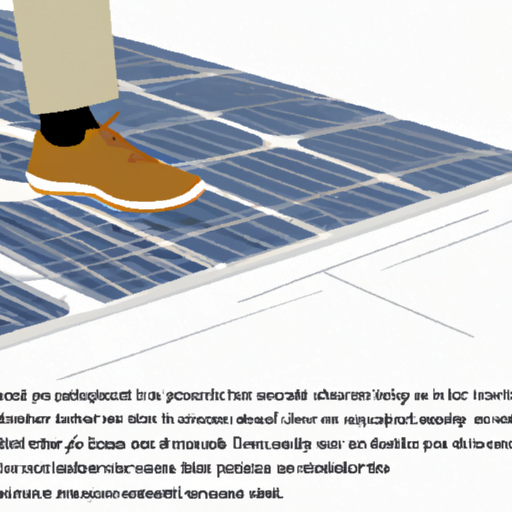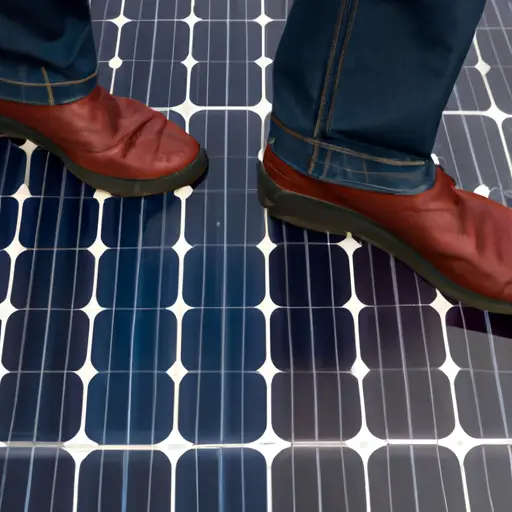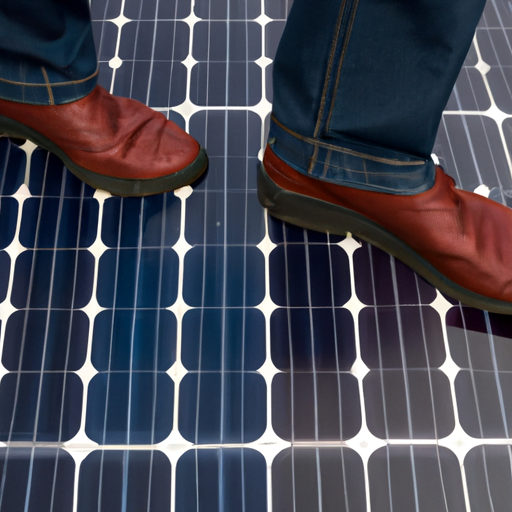So, have you ever wondered what it would be like to live off the grid? You know, relying on renewable energy sources anddisconnecting from the traditional power grid. It’s an intriguing idea, isn’t it? One of the most popular forms of renewable energy is solar power. I mean, who hasn’t seen those shiny panels on rooftops, harnessing the power of the sun? But here’s a question that might have crossed your mind – can you actually walk on solar panels? Let’s dig into that a bit more, shall we?
When it comes to solar panels, their main purpose is to capture sunlight and convert it into electrical energy. They consist of semiconductor materials, typically silicon, which absorb photons from the sun’s rays and generate electricity through the photovoltaic effect. Now, these panels are built to be sturdy and resilient, able to withstand various weather conditions like rain, heat, and snow. But walking on them? Hmm, let’s think about that.
While solar panels are designed to withstand normal wear and tear, they are not generally meant to be walked on. The surface of solar panels is made up of delicate glass layers, and excessive weight or pressure can cause them to crack or shatter. This can lead to a decrease in their efficiency and even render them useless. However, there are some specialized solar panels that are built to be more durable and can withstand heavier loads, known as walkable solar panels. But even these have their limits, and it’s generally recommended to avoid walking on any solar panels whenever possible.
In conclusion, while it may be fascinating to imagine ourselves leisurely strolling on top of solar panels, it’s not a practical or advisable thing to do. Solar panels are designed to capture sunlight, not support our weight. If you’re interested in installing solar panels for your home or business, it’s important to remember to treat them with care and avoid putting unnecessary pressure on them.

Introduction
Solar energy is gaining popularity as a sustainable and renewable source of power. Solar panels, also known as photovoltaic (PV) panels, play a crucial role in harnessing the energy from the sun and converting it into usable electricity. However, many people are curious about whether it is safe to walk on solar panels. In this article, we will explore the factors affecting the ability to walk on solar panels, the potential risks involved, and preventive measures to ensure the longevity of these solar power systems.
Understanding Solar Panels
To understand the implications of walking on solar panels, it is essential to grasp their basic functioning and composition. Solar panels are comprised of multiple PV cells, which are responsible for converting sunlight into electricity. These cells are typically made of silicon, a semiconductor material that allows electrons to move when exposed to sunlight.
The composition of solar panels includes a protective layer on the front, often made of tempered glass, which shields the PV cells from external elements. Additionally, there are encapsulants that protect the PV cells, as well as a backsheet to protect against moisture and other environmental factors.
There are various types of solar panels available, including monocrystalline, polycrystalline, and thin-film options. Each type has its advantages and disadvantages in terms of efficiency, cost, and appearance. However, when it comes to walking on solar panels, the type and construction play a crucial role.
Can You Walk on Solar Panels?
Walking on solar panels is generally not recommended due to potential risks. Although solar panels are sturdy and can withstand various weather conditions, they are not designed to support the weight of a person. The standard construction of solar panels is not meant to be walked upon, and doing so can lead to severe damage or reduced performance.
Importance of Solar Panel Durability
The durability of solar panels is crucial for their long-term functioning. Given their exposure to harsh weather conditions, extreme temperatures, and potential impacts, solar panels need to be able to withstand these challenges to ensure their efficiency and reliability. Walking on solar panels can compromise their structural integrity, leading to cracking, loose connections, or even shattered glass.
Solar Panel Weight Capacity
Solar panels are typically affixed to supporting structures, such as rooftops or ground-mounted systems. While they are designed to withstand the weight of the panels themselves, they are not engineered to support additional loads, such as a person’s weight. Putting pressure on solar panels can exceed their weight capacity, leading to structural damage to both the panels and the supporting structure.
Potential Damage from Walking on Solar Panels
Walking on solar panels can result in various types of damage. The most evident risk is physical damage, such as cracks in the PV cells or the glass cover. These cracks can hamper the effectiveness of the solar panel, reducing its ability to convert sunlight into electricity.
Furthermore, walking on solar panels can cause electrical hazards. A damaged panel may expose live components, leading to the risk of electric shock. It is essential to remember that solar panels generate electricity, and any interference with their internal wiring can be dangerous.
Moreover, walking on solar panels can void warranties or insurance coverage. Most solar panel manufacturers provide warranties against defects and damage. However, unauthorized tampering or negligence, such as walking on the panels, can render these warranties void. This can result in financial losses if any issues arise with the solar panel system.
Factors Affecting Walking on Solar Panels
Understanding the factors that influence the ability to safely walk on solar panels is crucial. Several factors determine the risk involved and the potential damage that can occur.
Type of Solar Panel
The type of solar panel plays a significant role in its vulnerability to damage from walking. Thin-film solar panels, for example, are more flexible and less structurally robust than crystalline-based panels. As a result, they are more prone to damage and should be handled with extra care. Crystalline-based panels, on the other hand, are more rigid and have a higher tolerance for external pressure.
Supporting Structures
The structure on which the solar panels are installed is another important consideration. Rooftop installations should follow specific guidelines to ensure the panels’ integrity and protect the underlying roof structure. Ground-mounted systems also require proper foundations and supports to prevent damage from external factors, including walking on the panels.
Installation Techniques
The way solar panels are installed can also impact their ability to withstand the weight of a person. If the installation is not done correctly and securely, the panels may be more susceptible to damage. It is crucial to follow proper installation procedures recommended by the manufacturer or seek professional help.
Geographical Location and Climate
The geographical location and climate of an area can affect the durability of solar panels. Areas prone to heavy snowfall, hailstorms, or high winds may require additional measures to ensure the panels’ resistance to these elements. Walking on solar panels in these regions can be even riskier due to potentially harsher weather conditions.
Maintenance and Care Practices
Regular maintenance and care practices significantly influence the longevity of solar panels. It is important to keep the panels clean and free from debris to maximize their efficiency. However, caution must be exercised when cleaning, as aggressive techniques or abrasive materials can cause damage. While inspecting and maintaining solar panels, it is crucial to avoid putting any weight or pressure on them.

Walking on Solar Panels Risks
Walking on solar panels poses several risks, both to the integrity of the panels and to personal safety.
Cracked or Damaged Panels
As previously mentioned, applying pressure to solar panels can lead to cracks or other damage. Cracked panels can reduce the effectiveness of the solar array, as light is blocked from reaching the PV cells. This translates to reduced energy production and lower overall efficiency.
Reduced Panel Performance
Even if the damage is not immediately apparent, walking on solar panels can affect their performance over time. Damage to the protective layers, encapsulants, or connections can lead to moisture infiltration or increased electrical resistance. These issues can diminish the efficiency and output of the solar panels.
Electrical Hazards
Walking on solar panels can expose live electrical components and create the risk of electric shock. Solar panels generate direct current (DC) electricity, which can be dangerous if mishandled. To avoid electrical hazards, it is essential to respect the electrical integrity of the panels and avoid any interference with the wiring or connections.
Voiding Warranties or Insurance
Manufacturers typically provide warranties against defects and certain types of damage. However, walking on solar panels can void these warranties. Similarly, insurance coverage for solar panel systems may stipulate specific maintenance requirements or guidelines. Failure to comply with these provisions, including walking on the panels, can result in the denial of insurance claims.
Expert Opinions and Studies
To gain further insights into the risks associated with walking on solar panels, it is essential to consider expert opinions and research studies.
Industry Experts’ Views on Walking on Solar Panels
Most solar panel manufacturers and industry experts strongly advise against walking on solar panels. They emphasize the potential damage and risks, including reduced performance, electrical hazards, and voided warranties or insurance. It is generally recommended to leave any maintenance or repair work to trained professionals who understand the risks and can take appropriate precautions.
Research Studies on Panel Durability
Numerous studies have been conducted to assess the impact of external factors, including walking, on solar panel durability. These studies have consistently shown that walking on solar panels can lead to damage and reduced performance. The structural integrity of the panels is compromised, and the overall efficiency is negatively affected.
Impact of Walking on Solar Panel Efficiency
Walking on solar panels can reduce their efficiency by blocking out sunlight or hindering the operation of the PV cells. Even small cracks or minor damage can disrupt the movement of electrons, impacting the electricity production. This reduction in performance can result in lower energy generation and decreased financial returns on the solar panel investment.
Preventive Measures
To ensure the longevity and effectiveness of solar panel systems, it is essential to take preventive measures and exercise caution when managing their maintenance and care.
Avoidance of Walking on Solar Panels
The best way to prevent damage from walking on solar panels is to avoid doing so altogether. Instead, opt for alternative maintenance techniques or seek professional help when needed. Trained technicians have the expertise to safely inspect and maintain solar panels without compromising their integrity.
Alternative Maintenance Techniques
Several alternative methods can be used for solar panel maintenance without walking on them. These include using long-handled brushes or soft cloths to clean the panels from the ground or using specific cleaning devices designed for solar panel maintenance. These methods allow for regular upkeep without the risks associated with walking on the panels.
Safety Measures for Maintenance Personnel
In cases where maintenance or repair work must be conducted directly on the solar panels, proper safety measures should be implemented. This includes using appropriate personal protective equipment, such as non-slip footwear, safety harnesses, and insulated tools. Following safety protocols and industry best practices can help mitigate risks and ensure the safety of maintenance personnel.
Future Developments
As the demand for solar energy continues to grow, advancements in solar panel technology are anticipated. These developments aim to enhance the durability and resilience of solar panels, reducing the risks associated with walking on them.
Improvements in Solar Panel Design
Researchers and manufacturers are continually working on new material compositions and panel designs to increase their durability. This includes exploring methods to reduce the weight of solar panels without compromising their structural integrity. By making panels more robust and resistant to external pressure, the risks associated with walking on them can be minimized.
Emerging Technologies for Increased Durability
Emerging technologies, such as self-healing materials and enhanced encapsulants, show promise in improving the durability of solar panels. These advancements aim to address the vulnerabilities and potential damage caused by walking or external factors. By incorporating these technologies into solar panel systems, their resistance to cracks, moisture, and physical stress can be significantly enhanced.
Enhancements in Installation Methods
Proper installation is crucial for the long-term performance and durability of solar panels. As the industry evolves, installation techniques are expected to improve, ensuring the secure attachment of panels and supporting structures. By implementing innovative installation methods, the risks of damage from walking on solar panels can be minimized.
Conclusion
In conclusion, it is not advisable to walk on solar panels due to the potential risks involved. Solar panels are engineered to withstand various weather conditions but are not designed to support the weight of a person. Walking on solar panels can result in damage, reduced performance, electrical hazards, and voided warranties or insurance.
To ensure the longevity and effectiveness of solar panel systems, it is crucial to avoid walking on them and seek alternative maintenance techniques or professional assistance when needed. Safety measures should be followed for maintenance personnel, and regular inspections should be conducted to identify any potential issues with the panels.
As solar panel technology continues to advance, future developments will focus on increasing the durability and resilience of solar panels. Through improved design, emerging technologies, and enhanced installation methods, the risks associated with walking on solar panels can be minimized. The goal is to ensure that solar energy remains a viable and sustainable source of power for years to come.




